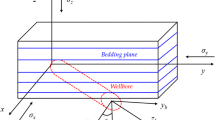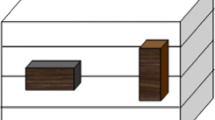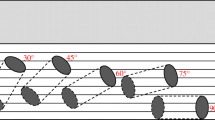Shale gas exploration and development have become a hot spot in the natural gas industry. Providing wellbore stability is one of the major engineering problems occurring in the process of drilling of horizontal shale gas wells. In this paper, based on circumferential stress analysis of horizontal wells and analysis of the geometrical relationship of bedding planes and the wellbore, a new horizontal wellbore stability model is introduced. The proposed model takes into account the effect of bedding planes and water content on the strength parameters of shale. Based on actual field data of a shale gas well, the proposed model is compared with the wellbore stability model for an intrinsic rock formation. The results show that the existence of bedding planes affects the stability of a wellbore, making it less stable. Meanwhile, the maximum and minimum values of collapse pressure density for different azimuths of wellbore increase linearly with increase in water content. Moreover, the results also show that factors of the wellbore azimuths and the bedding planes dip angle and dip direction have a significant impact on the wellbore stability of horizontal shale gas wells.






Similar content being viewed by others
References
Z. Shenand and K. Ling, “Maintaining horizontal well stability during shale gas development,” in: SPE Middle East Unconventional Gas Conference and Exhibition, Muscat, Oman, 28-30 January (2013), SPE-164037.
J. C. Jaeger, N. G W. Cook, and R. W. Zimmerman, Fundamentals of Rock Mechanics (Fourth Edition), John Wiley & Sons, New York (2009).
W. B. Bradley, “Failure of inclined boreholes,” J. Energ. Res. Technol., 101(4), 232-239 (1979).
M. Josh, L. Esteban, C. Delle Piane et al, “Laboratory characterisation of shale properties, “J. Pet. Sci. Eng., 88,107-124 (2012).
M. K. Al-Arfaj, M. Amanullah, A. S. Sultan et al, “Chemical and mechanical aspects of wellbore stability in shale formations: A literature review,” in: Abu Dhabi International Petroleum Exhibition and Conference, Abu Dhabi, UAE, 10-13 November (2014), SPE-171682-MS.
M. A. Islam and P. Skalle, “An experimental investigation of shale mechanical properties through drained and undrained test mechanisms,” Rock Mech. Rock Eng., 46(6), 1391-1413 (2013).
M. Frydman and S. A. Fontoura, “Modeling aspects of wellbore stability in shales,” in: SPE Latin American and Caribbean Petroleum Engineering Conference, Buenos Aires, Argentina, 25-28 March (2001), SPE-69529-MS.
S. H. Ong and J. C. Roegiers, “Fracture initiation from inclined wellbores in anisotropic formations,” J Pet. Technol, 48(7), 612-619 (1996).
G. Yan, F. Karpfinger, R. Prioul et al, “Anisotropic wellbore stability model and its application for drilling through challenging shale gas wells,” in: International Petroleum Technology Conference, Kuala Lumpur, Malaysia, 10-12 December (2014), IPTC-18143-MS.
Y. Li, Y. Fu, G Tang et al., “Effect of weak bedding planes on wellbore stability for shale gas wells,” in: IADC/SPE Asia Pacific Drilling Technology Conference and Exhibition, Tianjin, China, 9-11 July (2012), SPE-155666-MS.
J. Gao, T. Odunlami, and N. Osayande, “Shale bedding impact on wellbore stability and drilling optimization,” in: SPE/CSUR Unconventional Resources Conference, Calgary, Alberta, Canada, 30 September —2 October (2014), SPE-171601-MS.
J. Zhang, “Borehole stability analysis accounting for anisotropies in drilling to weak bedding planes,” Int. J. Rock Mech. Min. Sci., 60, 160-170 (2013).
R. Huang, M. Chen, J. Deng et al, “Study on shale stability of wellbore by mechanics coupling with chemistry method,” Drill. Fluid Compl. Fluid, 12(3), 15-21(1995).
Y. H. Lu, M. Chen, Y. Jin et al, “A mechanical model of borehole stability for weak plane formation under porous flow,” Pet. Sci. Technol, 30(15), 1629-1638 (2012).
Author information
Authors and Affiliations
Corresponding author
Additional information
Translated from Khimiya i Tekhnologiya Topliv i Masel, No. 5, pp. 57 — 61, September — October, 2020.
Rights and permissions
About this article
Cite this article
Li, W., Li, W., Dai, F. et al. A New Wellbore Stability Model for Shale Gas Horizontal Wells with Effects of Bedding Planes and Water Content. Chem Technol Fuels Oils 56, 783–791 (2020). https://doi.org/10.1007/s10553-020-01191-x
Published:
Issue Date:
DOI: https://doi.org/10.1007/s10553-020-01191-x




